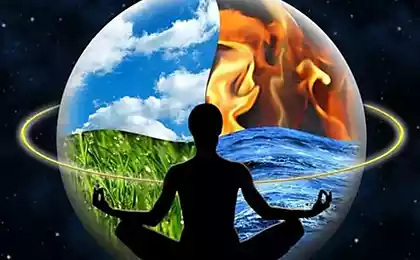805
Five primary elements. Theory of the Five Elements

The contemplation and observation of the universe allowed the ancient Taoists to create a theory that explained the equilibrium established between the complementary and opposite entities of which the universe consists. The characteristics of these dynamic entities or units, and their relations with each other, are set forth in the theory of the five elements.
According to this theory, the life force, in its countless manifestations, is born and dies through the interaction of the five elements: fire, earth, metal, water and wood. This model, which consists of five elements, belongs to Taoism; the ancient Western philosophy, as well as the Indian one, was based on a model that included only four elements, or elements: earth, air, water and fire. For Taoists, air is included in the concept of fire, because without air, fire cannot burn.
There are two cycles illustrating the interaction between elements. In the first cycle, which is called the generation cycle, each of the elements generates or produces the following element: wood produces fire, fire produces earth, earth produces metal, metal produces water, and water produces wood, which naturally leads to the beginning of the cycle. In the second cycle, which is called the cycle of destruction, each of the elements destroys, or absorbs, the next element. So water destroys metal, metal destroys wood, wood absorbs water, water absorbs fire, fire destroys metal, and the cycle begins again.
Just as the universe maintains its equilibrium through the interaction of the five elements, the human body, which is the microcosm of the universe, maintains the harmony of the mental and physical principles through the same interaction of the five elements. Energy circulates in the body, using the meridians and the corresponding organs and insides, following strictly defined cycles. And these cycles, illustrating the circulation of energy in the body, are a reflection of those two cycles, which were the interaction between the five elements. For the Taoists, each of the human interiors is associated with one of the five elements.
In the first cycle, each of the organs connects to its corresponding element, which leads to the following result: the heart (fire) supports the spleen and pancreas (earth), the spleen and pancreas (earth) support the lungs (metal), the lungs (metal) support the kidneys (water), the kidneys (water) support the liver (wood), and the liver (wood) supports the heart (fire). The intestines are also subject to this cycle: the small intestines (fire) support the stomach (earth), the stomach (earth) supports the large intestines (metal), the large intestines (metal) support the bladder (water), and the bladder (water) supports the gallbladder (tree).
Elements and their correspondence to organs and insides:
Fire - heart, small intestine, endocrine glands, blood vessels
Metal - lungs, large intestine, skin
Water - kidneys, bladder, bones
Earth - spleen, pancreas, stomach, muscles
Tree - liver, gallbladder, nerves
If one of the organs is disturbed, it not only can no longer support the organ following it on the meridian path, but also has a negative effect on this organ or provokes a negative effect on itself. However, this is what the second cycle shows us, that is, the cycle in which each element destroys or absorbs the next element. When the balance of energy in the heart (fire) is disturbed, the heart (fire) negatively affects the lungs (metal); the lungs (metal) negatively affects the liver (wood); the liver (tree) negatively affects the spleen - the pancreas (earth); the spleen - the pancreas (earth) negatively affects the kidneys (water): and the kidneys (water) have an adverse effect on the heart (fire). This model is also applicable to the insides: the imbalance of energy in the small intestines (fire) leads to a negative effect on the large intestines (metal): the colon (metal) adversely affects the gallbladder (tree); the gallbladder (tree) has a negative effect on the stomach (earth); the stomach (earth) negatively affects the bladder (water); and the bladder (water) adversely affects the small intestines (fire).
By showing that the cyclic interaction between organs and intestines is identical to the interaction between elements, the Taoists gave their followers a plausible explanation of such statements as “what is above is no different from what is below” and “the microcosm is the mirror of the macrocosm”, which allowed them to later speak of the exchange of energy between organs and intestines as an established fact, since they proved that this interaction is based on the same logic that makes it possible to instinctively perceive the interaction of the five elements as an undeniable phenomenon.
























